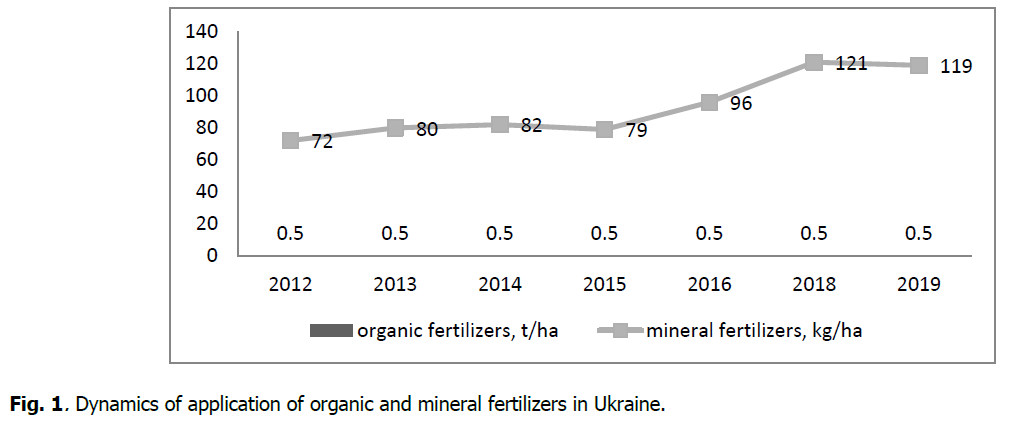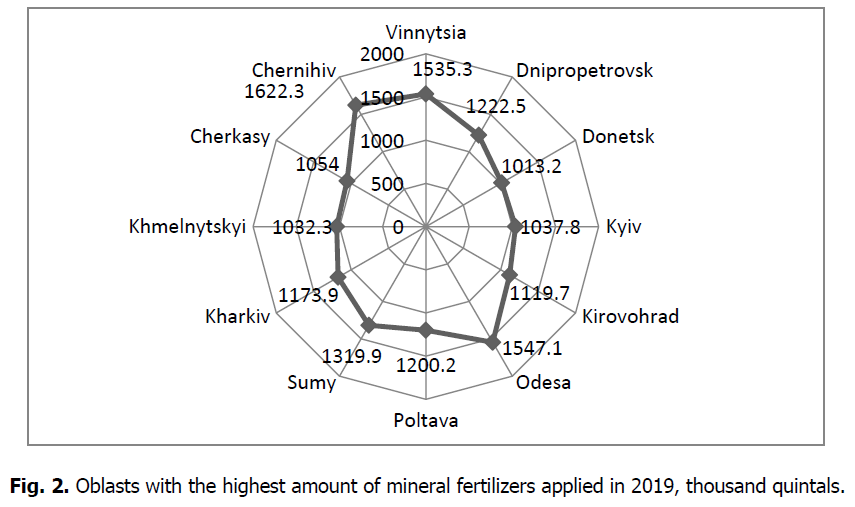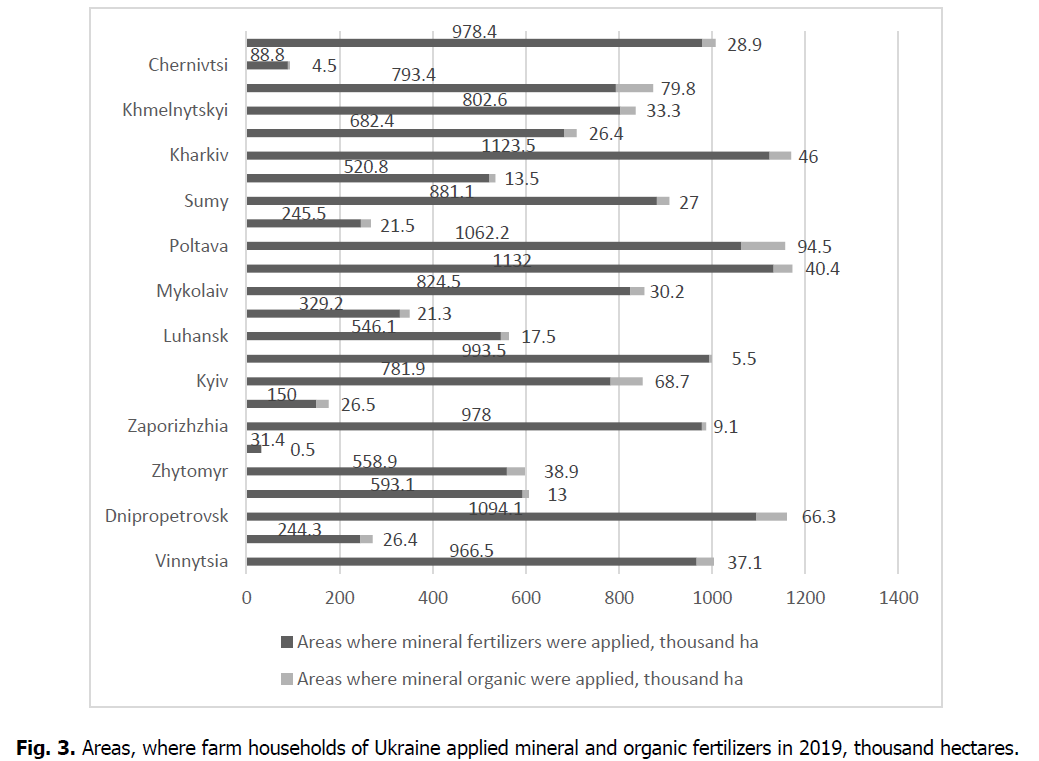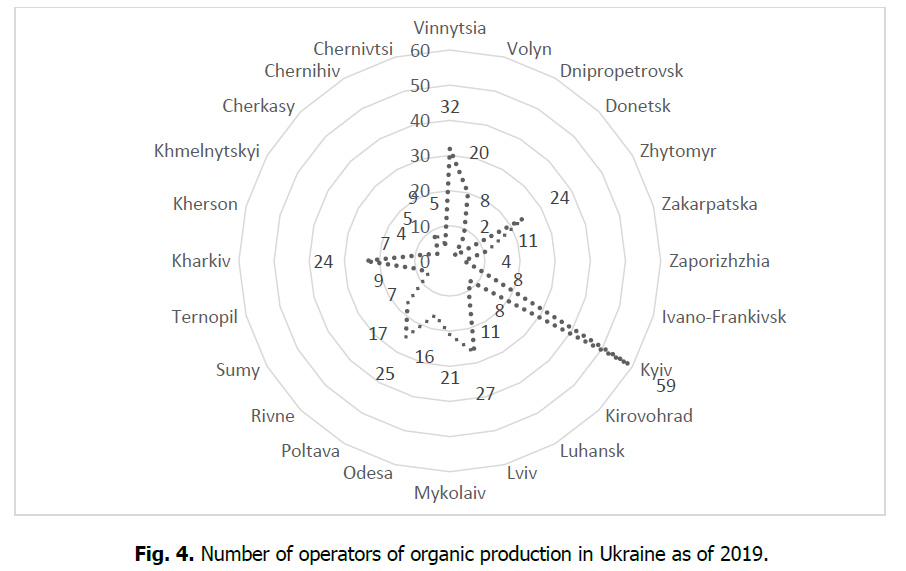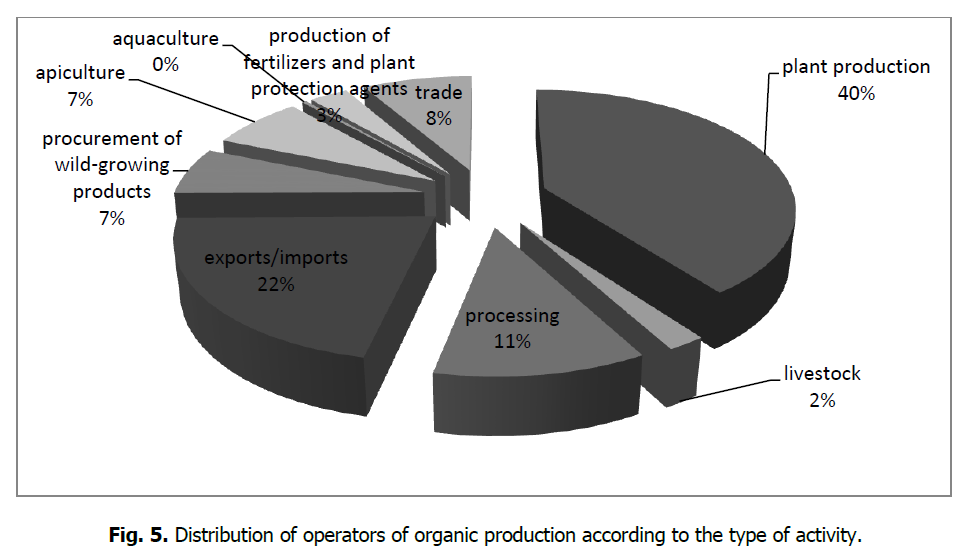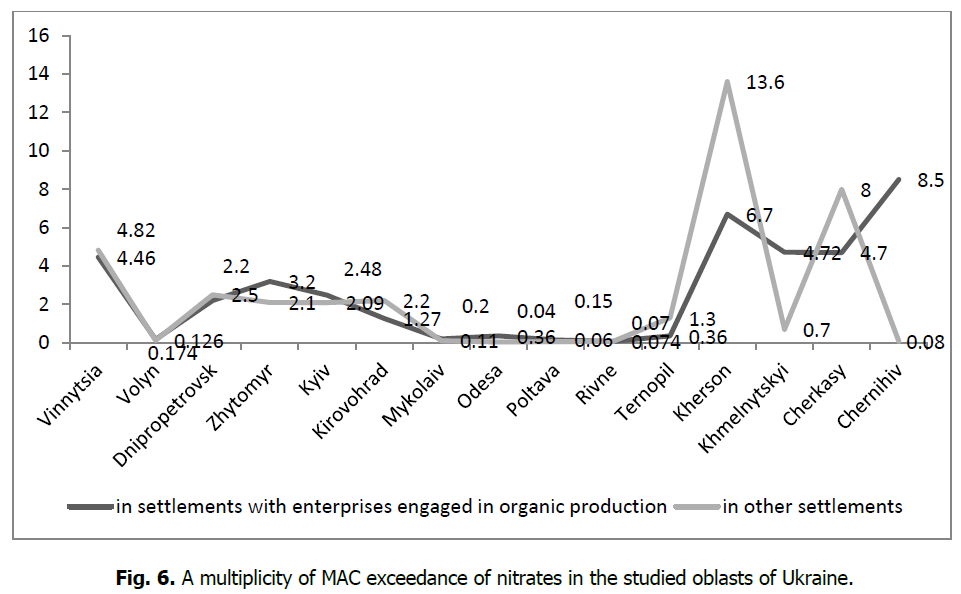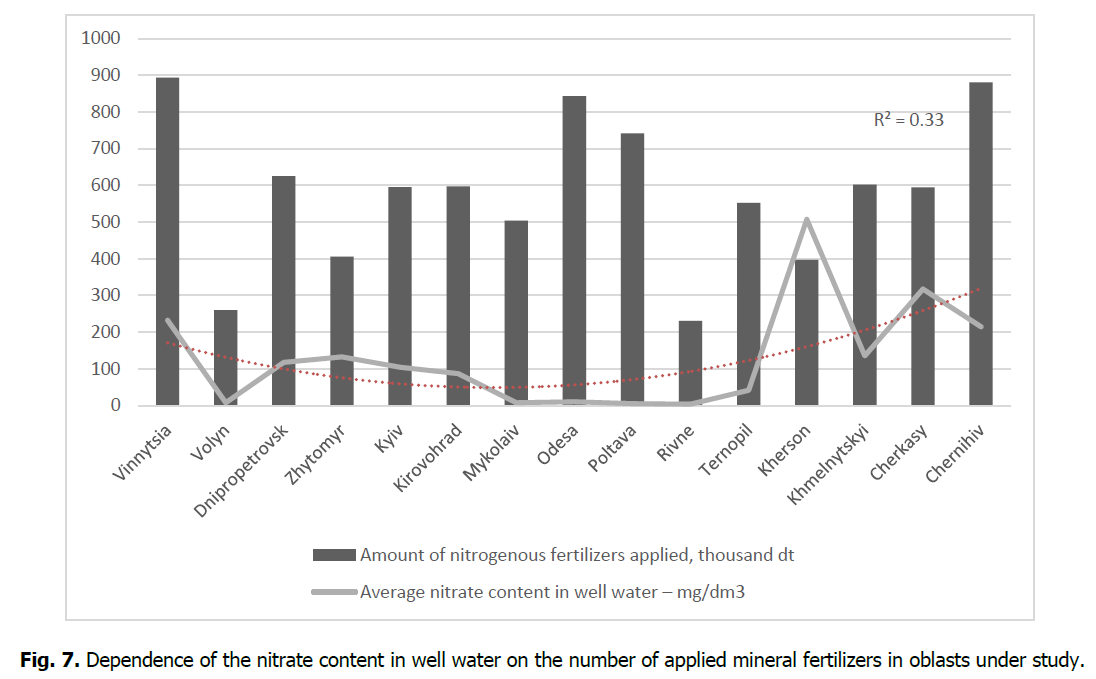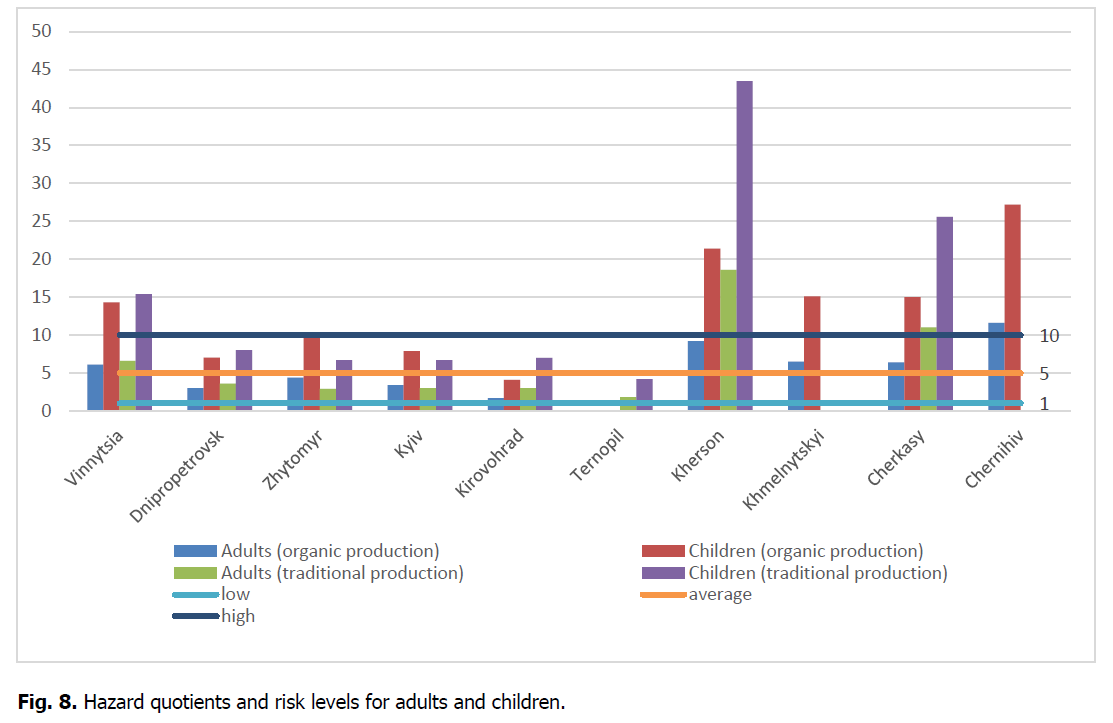Research Article - (2021) Volume 11, Issue 2
Assessment of the impact of organic Agriculture on Nitrate Content in Drinking Water in Rural Settlements of Ukraine
L. D. Romanchuk, R. A Valerko*, L. O. Herasymchuk and L. O. HerasymchukAbstract
Without question, there is a negative impact of traditional agriculture on the environment, and in particular on the pollution of groundwater used by the rural population as sources of drinking water. This issue has continuously been studied by scientists from different countries. The introduction of the principles of organic production, which are based on the prohibition of the use of hazardous chemicals in agricultural activities, will make it possible to reduce the negative impact on the environment, not upset the natural balance and obtain environmentally friendly products. The issue of pollution of water resources with nitrates that come in with agricultural effluents has become global and is reflected in European legislation, namely in Directive No. 91/676/EEC. Studies related to the assessment of the impact of organic agriculture on nitrate content in drinking water from the sources of non-centralized water supply in rural settlements have been conducted in 15 oblasts of Ukraine. Exceedance in the content of nitrate compounds has been recorded in 10 oblasts under study; and this applied to both settlements with organic and traditional agriculture. However, the assessment of the dependence of nitrate content in well water on the amount of applied nitrogenous fertilizers in oblasts of Ukraine under study was not reliable, as the approximation coefficient is 0.33, which indicates a low level of dependence. The most critical situation has been found in rural settlements of Kherson oblast, where the exceedance of the average nitrate content was almost 14 MAC for areas with traditional agriculture and almost 7 MAC for settlements where organic agricultural production predominates. The assessment of the hazard quotient in this area indicates a critical level of occurrence and development of harmful effects on public health, especially for children; there may be mass complaints and the emergence of chronic diseases.
Keywords
Drinking Water, Nitrates, Fertilizers, Agriculture, Organic Production, Risk.
Introduction
Intensive farming involves applying many artificial non-natural substances, such as mineral fertilizers and chemical plant protection agents. Such substances make it possible to obtain consistently high yields of agricultural plants to meet the population's food needs. However, there is a downside to intensive farming. Above all, this is the low quality of food, contaminated with heavy metals, nitrates, pesticide residues. Also, environmental pollution is a negative phenomenon, which involves the exceedance of pollutants in soil, water bodies, air and drinking water.
Numerous studies have shown that the application of large amounts of mineral fertilizers, especially nitrogenous ones, leads to the exceedance of nitrates allowable drinking water levels (Sasakova et al., 2018; Hansen et al., 2017; Palapa, 2009). Nitrates are among the most common anthropogenic groundwater pollutants, the vast majority of which enter the human body with drinking water and vegetable products (Valerko et al., 2018; Herasymchuk, 2015). Systematic human consumption of water and vegetables with excessive nitrate content may be associated with such adverse effects on human health as methemoglobinemia, negative reproductive effects and specific cancer types (De Simone, 2009).
Nitrate contamination of groundwater in agriculture is a matter of serious concern to the European Union (Sutton et al., 2011; Addiscott et al., 2011). Since 1991, the EU has identified vulnerable zones and promoted the introduction of best agricultural practices in the Directive 91/676/EEC concerning water protection against pollution caused by nitrates from agricultural sources. However, the implementation of this Directive in Ukraine is a rather complicated process, as there are many land users and producers in the country’s agriculture who use mineral fertilizers containing nitrogenous substances. As a rule, both land users and agricultural producers do not have sufficient funding to implement systems of water and land use that would enable them to move to European standards for the use of mineral and organic fertilizers, as well as the storage of nitrogenous substances (Holyan et al., 2015).
Following the Sustainable Development Strategy for Ukraine by 2030, it is envisaged to maintain the environment in a proper state that will ensure the quality of life and well-being of present and future generations. One effective means of maintaining the environment is the greening of agricultural production by switching to organic production. The main principles of organic production are the minimization of mineral fertilizers and chemical plant protection agents and their prohibition, making it possible to obtain environmentally friendly products, reduce the negative impact on the environment and not upset the natural balance.
Thus, the study's purpose was to assess the impact of organic agriculture on nitrate content in drinking water from the sources of non-centralized water supply in rural areas of Ukraine, within which there are farms engaged in organic and traditional agricultural production.
Methods
The study was conducted during 2019-2020 in 15 oblasts of Ukraine in rural settlements where organic and traditional agriculture is conducted, the predominant activity being plant production (Table 1). A sampling of drinking water, transportation, and storage of samples carried out according to the state standard. According to generally accepted methods, analytical studies of water samples were carried out in a certified measuring laboratory of the Training and Research Center for Ecology and Environmental Protection of Polissia National University.
| Oblast | Settlement | Organic agriculture | Traditional agriculture | |
|---|---|---|---|---|
| 1 | Vinnytsia | Village Luka-Meleshivska | + | |
| Village Krasnopilka | + | |||
| Village Trostianets | + | |||
| 2 | Volyn | Small Town Manevychi | + | |
| Village Zarichchia | + | |||
| 3 | Dnipropetrovsk | Village Znamenivka | + | |
| Village Taromske | + | |||
| 4 | Zhytomyr | Village Suiemtsi | + | |
| Village Rogachiv | + | |||
| Village Ostrozhok | + | |||
| 5 | Kyiv | Village Havronshchyna | + | |
| Village Litochky | + | |||
| 6 | Kirovohrad | Village Zelenyi Barvinok | + | |
| Village Holovkivka | + | |||
| 7 | Mykolaiv | Village Mishkovo-Pogorilove | + | |
| Village Doroshivka | + | |||
| 8 | Odesa | Village Safiany | + | |
| Village Sverdlovo | + | |||
| 9 | Poltava | Village Shushvalivka | + | |
| Village Erkl | + | |||
| 10 | Rivne | Village Krasnosillia | + | |
| Small Town Goshcha | + | |||
| 11 | Ternopil | Small Town Buchach | + | |
| Village Zhyznomyr | + | |||
| 12 | Kherson | Village Oleshky | + | |
| Village Maiachka | + | |||
| 13 | Khmelnytskyi | Village Sakhnivtsi | + | |
| Village Yarmolyntsi | + | |||
| 14 | Cherkasy | Village Khrystynivka | + | |
| Village Palanka | + | |||
| 15 | Chernihiv | Village Chemer | + | |
| Village Beremytske | + |
Table 1. Scheme of sampling drinking water from the sources of water supply in rural settlements of Ukraine.
To obtain data on the potential and actual health hazards in oblasts where the average nitrate content in drinking water exceeded the allowable values, a risk assessment methodology has been chosen (Lototska, Prokopov, 2018). According to the methodology, formulas 1 and 2 determined quantitative risk indicators. The average daily dose of a chemical entrance during 30 years (ADD), the threshold (reference) dose (RfD) and the hazard quotient (HQ) were calculated as indicators of the toxic effect of nitrates as a result of constant consumption of contaminated water without purification.
The average daily dose of a chemical that enters the body together with drinking water during human life was calculated by formula 1:
АDD = С × ІR × ЕD × ЕF / ВW × АТ × DРY, (1)
where АDD – An average daily dose of the entrance of a chemical during life, mg/kg × day; С – concentration of a chemical in drinking water, mg/dm3; ІR – The value of water consumption: adults - 2 dm3/day, children – 1 dm3/day; ЕD – Effect duration: adults - 30 years, children – 6 years; ЕF – Effect frequency: 350 days/year; ВW – Body weight: Adults - 70 kg, Children – 15 kg; АТ – Averaging period of exposure: Adults - 30 years, Children – 6 years; DРY – Number of days per year: 365 days/year.
The indicators of hazard quotients assessed the risk of possible development of non-cancerogenic effects. The hazard quotient (HQ) is the ratio of the average daily dose of a chemical to its safe (reference) effect, calculated according to: formula 2:
НQ = АDD / RfD, (2)
where АDD – An average daily dose of the entrance of a chemical during life, mg/kg˟day;bRfD – threshold (reference) dose, mg/kg˟day.
Results and Discussion
The health and well-being of the rural population suffer from poor water resource management and undesirable farming methods. According to the Ministry of Regional Development, Construction and Housing of Ukraine, in 2019, only 30.1% of the rural population had access to a centralized water supply; the rest of the population is forced to use water from the sources non-centralized water supply to meet their drinking needs. The water quality in such sources is questionable and often does not meet the established standards for the content of nitrates, nitrites, total iron, chlorides, and sulfates, organoleptic, microbiological and radiological indicators.
The problem of pollution of drinking water from the sources of non-centralized water supply in rural settlements with nitrates is currently addressed in many studies by both foreign and domestic scientists who look at the ways of entering into water sources and the reasons for exceedance of their content in drinking water, as well as the impact of nitrates on human health.
Exceedance of nitrate content in well water due to intensive agriculture has been reported worldwide, including the United States (Sahoo et al., 2016), Europe (Laegreid et al., 1999), Australia (Thorburn et al., 2003), China (Cui et al., 2010), Germany (Van der Ploeg et al., 1999), Spain (Zufiaurre et al., 2020), France (Beaudoin et al., 2005), Bangladesh (Akber et al, 2020).
The level of nitrate content in water resources is increasing in many regions of the world mainly due to inorganic fertilizers and livestock manure in agricultural areas (Ward et al., 2018). Nitrogenous fertilizers are the primary anthropogenic source of nitrogen in the environment (Wheeler et al., 2015); their use increased exponentially after developing the Haber-Bosch process in the 1920s, and intensive use of synthetic fertilizers on agricultural land began after 1980. Almost half of all nitrogen effluents from agricultural fields enter surface and groundwater, which has led to an increase in the concentration of nitrates in water resources (Davidson et al., 2012).
Intensive agricultural production in Denmark poses a threat to groundwater quality due to nitrogen leaching from the soil into groundwater. Therefore, the nitrate content in groundwater in rural areas of the country is closely associated with the amount of nitrogen applied on agricultural land (Hansen et al., 2012).
Similar studies have been conducted in some agroeconomic rural areas of North Rajasthan in India. It has been found that the average nitrate content in all water samples from the sources of non-centralized water supply indicates the unsuitability of groundwater for drinking purposes. Constant consumption of such water can pose a severe threat to local people's health (Suthar et al., 2009).
Thus, the main problem of providing quality drinking water to the population in rural settlements is that the water coming from the sources of centralized water supply is regularly monitored, including the nitrate content, and, as a rule, its content even in agricultural areas is much lower than the established WHO standard, which is 50 mg/dm3. Water quality in the sources of non-centralized water supply, which are most often used in rural areas, is occasionally monitored; constant monitoring is not carried out (Wheeler et al., 2015).
An alternative to intensive agriculture is organic production, which causes only minimal environmental pollution. However, this issue remains controversial. In particular, some studies (Dahan et al., 2014) present the assessment of the nitrate content in water seeping from organic and conventional intensive greenhouses. Surprisingly, intensive organic farming based on solid organic matter, such as composted manure, which is applied to the soil as a single fertilizer before planting, has led to a significant influx of nitrates into groundwater. On the other hand, similar intensive agriculture, which uses liquid fertilizers through drip irrigation, as is practiced in traditional agriculture, has led to lower groundwater pollution rates with nitrates.
Other studies (Eckhardt and Stackelberg, 1995) show that out of the 90 monitored wells located on Long Island in the United States, the lowest nitrate content was recorded in water wells located in undeveloped land and underdeveloped areas than in those with developed agriculture.
Organic farming is already recognized as a good alternative to control pesticide pollution, maintain biodiversity and increase the number of all soil microorganisms (Sihi et al., 2020; Henneron et al., 2015). However, its impact on water pollution with nitrates remains controversial. The impact of organic production on the state of drinking water supply in terms of the nitrate content in rural settlements of Ukraine, near which the so-called "organic enterprises" are located, has not been assessed yet. Since the quality of life of the population depends on the nitrate content in drinking water from the sources of drinking water supply, this issue deserves researcher's attention and is quite acute and relevant.
Ukraine is one of the leading agricultural countries in the world. Having favorable natural and climatic conditions for growing plant products, Ukraine meets its own needs not and demonstrates significant export performance (Melnik et al., 2017). At the same time, the problem of the impact of agricultural production on the environment is acute. In particular, it is the pollution of water bodies by agricultural effluents containing excess amounts of mineral fertilizers.
According to the State Statistics Service of Ukraine, during 2012-2019 there was an increase in the number of mineral fertilizers, while the application of organic fertilizers remains virtually unchanged and is approximately within 0.5 t/ha (Figures. 1-3). However, if we compare these figures with those that were relevant before Ukraine became independent, there will be a significant difference: mineral fertilizers were then applied in the amount of up to 150 kg/ha, while organic ones about 10 t/ha (Melnik et al., 2017). The decrease in the number of mineral fertilizers was associated with the redistribution of agricultural production in the 1990s when most of it was transferred to rural households. The main reason for the sharp decline in organic fertilizers' application was a significant reduction in the cattle and pigs' population.
Figure 1: Dynamics of application of organic and mineral fertilizers in Ukraine.
Figure 2: Oblasts with the highest amount of mineral fertilizers applied in 2019, thousand quintals.
Figure 3: Areas, where farm households of Ukraine applied mineral and organic fertilizers in 2019, thousand hectares.
One way to solve the negative impact of agricultural production on the environment is its greening. As mentioned earlier, organic agriculture is based on environmentally friendly management principles, which improves product quality and reduces the negative impact on the environment.
Organic production in Ukraine began to develop in 1997. Its principal activities were the processing of organic grain, oil crops, legumes, and wild-growing herbs. Since 2007, organic producers' activities have expanded; organic bread, milk, sausages, fruit, vegetables, juice, beverages, syrups, jams, honey and cereals appear on the domestic market (Nosko, 2015).
The first Ukrainian certification body that inspects and certifies organic production is Organic Standard LLC, established within the Ukrainian-Swiss project Organic Certification and Development of the Organic Market in Ukraine in 2007 (organicstandard.ua/). According to Organic Standard LLC, in Ukraine, as of 2019, 383 operators of organic production are certified. The most significant number of them is located in Kyiv and Vinnytsia oblasts. More than 20 farm households produce organic products in Volyn, Zhytomyr, Lviv, Mykolaiv, Poltava and Kharkiv oblasts. More than ten organic producers are located in Zakarpatska, Luhansk, Odesa and Rivne oblasts. The smallest number of organic production operators is in the Donetsk oblast; there are only 2 of them, which is obviously due to the specialization of the oblast, as well as the fact that a joint force operation is currently ongoing there. There are from 4 to 9 organic producers on of Dnipropetrovsk, Zaporizhzhia, Ivano-Frankivsk, Kirovohrad, Sumy, Ternopil, Kherson, Khmelnytskyi, Cherkasy, Chernihiv and Chernivtsi oblasts (Figure. 4).
Figure 4: Number of operators of organic production in Ukraine as of 2019.
The plant production sector is the leading activity of organic enterprises; 40% of enterprises are engaged in it. The most significant number of enterprises engaged in crop cultivation is located in Dnipropetrovsk, Sumy, and Poltava oblasts, more than 80%. In general, in almost 71% of oblasts the plant production sector occupies 50 percent or more. The smallest number of plant production households is in the Mykolaiv oblast; there are no such enterprises in Luhansk oblast (Table 2, Figure. 5).
| Oblast | Certified activity | |||||||||
|---|---|---|---|---|---|---|---|---|---|---|
| Total | Plant production | Livestock | Processing | Exports/Imports | Procurement of wild-growing products | Apiculture | Aquaculture | Production of fertilizers and plant protection agents | Trade | |
| Vinnytsia | 52 | 37 | 2 | 6 | 14 | 2 | 3 | 3 | 6 | |
| Volyn | 20 | 13 | 1 | 4 | 7 | 5 | 1 | 1 | 1 | |
| Dnipropetrovsk | 8 | 7 | 2 | 1 | ||||||
| Donetsk | 2 | 1 | 1 | |||||||
| Zhytomyr | 24 | 16 | 3 | 8 | 13 | 3 | 1 | 5 | ||
| Zakarpatska | 11 | 4 | 3 | 7 | 4 | 1 | 2 | |||
| Zaporizhzhia | 4 | 2 | 1 | 1 | 3 | 1 | ||||
| Ivano-Frankivsk | 8 | 2 | 3 | 4 | 4 | 3 | ||||
| Kyiv | 59 | 36 | 1 | 10 | 16 | 5 | 1 | 4 | 6 | |
| Kirovohrad | 8 | 5 | 2 | 2 | 1 | |||||
| Luhansk | 11 | 11 | ||||||||
| Lviv | 27 | 16 | 2 | 5 | 11 | 5 | 1 | 3 | ||
| Mykolaiv | 21 | 3 | 2 | 1 | 16 | 1 | ||||
| Odesa | 16 | 10 | 1 | 5 | 1 | 1 | 3 | |||
| Poltava | 25 | 21 | 5 | 10 | 1 | 1 | 2 | |||
| Rivne | 17 | 12 | 3 | 8 | 1 | 4 | ||||
| Sumy | 7 | 6 | 1 | |||||||
| Ternopil | 9 | 6 | 1 | 2 | 3 | 3 | 1 | |||
| Kharkiv | 24 | 19 | 3 | 5 | 2 | 3 | ||||
| Kherson | 7 | 2 | 2 | 2 | 3 | 1 | ||||
| Khmelnytskyi | 4 | 1 | 2 | 2 | 3 | |||||
| Cherkasy | 5 | 3 | 1 | 1 | ||||||
| Chernihiv | 9 | 7 | 1 | 3 | 5 | 2 | 1 | |||
| Chernivtsi | 5 | 1 | 4 | 4 | 3 | 2 | ||||
Table 2. A The activity of certified enterprises engaged in organic production in Ukraine.
Figure 5: Distribution of operators of organic production according to the type of activity.
Only 2% of organic producers are engaged in animal husbandry. Organic livestock in Ukraine is represented by cattle breeding, pigs, sheep, goats and poultry. Production of organic cattle milk is developing most dynamically, with subsequent processing of raw materials to manufacture dairy and fermented milk products. Organic poultry breeding (chickens, ducks, geese) is also a promising Ukraine direction (Kutarenko, 2015). The most significant number of enterprises engaged in organic animal husbandry is located in Zhytomyr oblast; the vast majority belong to Galex-Agro (Table 2).
Organic production enterprises engaged in the processing of raw materials account for 11%. Most of them are located in Kyiv and Zhytomyr oblasts: 10 and 8 enterprises, respectively. Exports/imports of organic products come second after plant production, as the total number of such enterprises is 22%. Kyiv, Vinnytsia and Zhytomyr oblasts are the leaders in this field. The most significant number of enterprises engaged in the procurement of wild-growing products is located in Volyn, Kyiv, and Lviv oblasts. In general, in Ukraine, enterprises certified for the procurement of wild-growing products only in 12 oblasts. Only 7% of organic enterprises are engaged in apiculture. Mykolaiv oblast is the leader in this field; there are 16 such farm households there. In Luhansk oblast, it is the only type of certified activity. Currently, there are only two organic aquaculture enterprises in Ukraine, located in Kyiv and Kirovohrad oblasts. Seventeen enterprises located in 10 oblasts of Ukraine are engaged in producing organic fertilizers and plant protection agents. Their most significant number is located in Kyiv, Vinnytsia, and Kherson oblasts. Three percent of organic enterprises trade in organic products; the significant number is located in Vinnytsia and Kyiv oblasts (Table 2, Figure. 5).
Nitrate pollution of groundwater is a severe environmental problem of global concern among scientists worldwide, as it has a direct negative impact on human health through drinking water. Nitrates appear in groundwater due to the natural processes of decomposition of organic matter in the soil. However, their concentration can be significantly increased due to various anthropogenic sources, sncluding agriculture (Sahoo et al., 2016).
The exceedance of nitrate content is observed in 10 of the 15 studied oblasts; it exceeds the allowable amount from 1.3 to 13.6 times (Figure. 6). The worst situation is recorded in Kherson oblast, where the nitrate content is exceeded by 13.6 times in the village Maiachka, where farms are engaged in traditional agriculture.
In Vinnytsia, Kirovohrad, Ternopil, Kherson, and Cherkasy oblasts, there is a tendency to exceed of the nitrate content in drinking water in rural settlements, where traditional agriculture is conducted in comparison with the samples taken in settlements where organic agriculture prevails.
Figure 6: A multiplicity of MAC exceedance of nitrates in the studied oblasts of Ukraine.
The results of the study obtained in Chernihiv oblast proved to be quite convincing and exciting. Water samples were taken in the village Chemer, where the Eco-Park Agricultural Company LLC, which grows organic blueberries, operates. The nitrate content in wells in the village Chemer was critical and the exceedance was on average 8.5 times, which indicates the negative impact of agriculture on groundwater even though the company which operates in the village is engaged in organic production. Another settlement in Chernihiv oblast was the village Beremytske, which is located in the protected area of the oblast; there are no farm households on the territory and nearby. We found that, on average, the nitrate content in wells in the village Beremytske was much lower than the established standard, which also confirms the negative impact of agriculture on the state of drinking water.
In Zhytomyr, Kyiv, and Khmelnytskyi oblasts, the results of the study were ambiguous. In rural settlements with organic farms, the average nitrate content was higher than in traditional farming settlements. This is especially evident in the Khmelnytskyi oblast. In Vinnytsia and Dnipropetrovsk oblasts, the nitrate content in the compared settlements is approximately at the same level. In the remaining oblast under-study, the average nitrate content in drinking water from non-centralized water supply sources did not exceed the maximum allowable concentration (Figure. 6).
Besides, the dependence of nitrate content in well water in rural settlements of the studied oblasts of Ukraine on the amount of applied nitrogenous fertilizers was assessed. This dependence is described by a polynomial trend line of the second degree, and the value of the approximation is 0.33, which characterizes the low dependence of the nitrate content in the water on the amount of applied nitrogenous fertilizers (Figure. 7). Thus, apart from agricultural methods, the nitrate content in drinking water from non-centralized water supply sources in rural settlements is influenced by other anthropogenic factors.
Figure 7: Dependence of the nitrate content in well water on the number of applied mineral fertilizers in oblasts under study.
In our opinion, an increase in the level of average annual air temperature, which is currently observed in all oblasts of Ukraine, may be a significant factor that causes an increase in the nitrate content in groundwater. This, in turn, can reduce the amount of groundwater in shallow non-centralized individual water sources; this is especially the case of wells, some of which have dried up. Some Ukraine oblasts have already switched to using individual well bores, as water in wells has simply disappeared. This applies to Chernihiv, Kherson, Mykolaiv, and Odessa oblasts. Since there is much less water in wells and we tried to sample water only from wells, its quality became much worse, the concentration of dissolved substances in it increased, which, first of all, applies to nitrates.
Of course, the nitrate content can also be affected by the natural composition of rocks, accumulating excessive amounts of chemical elements due to their structure (Lototska, Prokopov, 2018). However, in our opinion, one of the most important and common reasons for this situation is the pollution of water in wells by sewage from outhouses and livestock farms, chemicals from fields, the fact that owners do not adhere to legislation on arrangement and maintenance of wells (Palapa, 2009).
Since the exceedance of nitrate content in water causes adverse effects on human health, the purpose was to assess the non-cancerogenic risk to adults and children in oblasts where the average nitrate content exceeded the allowable level. Risk assessment of non-cancerogenic effect was carried out by calculating the hazard quotient (HQ), reflecting the ratio of the estimated dose of a contaminant and the allowable dose (Lototska, Prokopov, 2018). The average daily dose of intake of nitrates with drinking water from the sources of non-centralized water supply during life for adults and children was calculated based on the average nitrate content in drinking water and traditional values such as water consumption per day, duration and frequency of exposure, body weight, averaging period exposure and several days per year. The results of the calculation are presented in Table 3.
| No | Oblast | Organic agriculture | Traditional agriculture | ||||
|---|---|---|---|---|---|---|---|
| Average nitrate content, mg/dm3 | ADD, mg/kg/day | Average nitrate content, mg/dm3 | ADD, mg/kg/day | ||||
| Adults | Children | Adults | Children | ||||
| 1 | Vinnytsia | 223 | 6.1 | 14.3 | 241 | 6.6 | 15.4 |
| 2 | Dnipropetrovsk | 110 | 3.01 | 7.03 | 125 | 3.6 | 8.0 |
| 3 | Zhytomyr | 160 | 4.4 | 10.2 | 105 | 2.9 | 6.7 |
| 4 | Kyiv | 124 | 3.4 | 7.9 | 104.5 | 3.0 | 6.7 |
| 5 | Kirovohrad | 63,5 | 1.7 | 4.1 | 110 | 3.0 | 7.0 |
| 6 | Ternopil | - | - | - | 65 | 1.8 | 4.2 |
| 7 | Kherson | 335 | 9.2 | 21.4 | 680 | 18.6 | 43.5 |
| 8 | Khmelnytskyi | 236 | 6.5 | 15.1 | - | - | - |
| 9 | Cherkasy | 235 | 6.4 | 15.0 | 400 | 11.0 | 25.6 |
| 10 | Chernihiv | 425 | 11.6 | 27.2 | - | - | - |
Table 3. Values of average daily doses for adults and children residing in oblasts where nitrate content exceeds the allowable level.
According to the guidelines, the value of the hazard quotient that characterizes the risk to public health from the consumption of drinking water contaminated with nitrates is ranked as follows: the value of HQ is equal to or less than 0.1 – minimal risk, 01-1 – low risk, 1-5 – average risk, 5-10 – high risk and more than 10 – critical risk.
The hazard quotient calculation showed that its value increases with growing concentration of nitrates in drinking water. The hazard quotient exceeds one already with exceeding the MAC by 1.3 times. Thus, for rural settlements where organic enterprises operate, average and high-risk levels have been established for adults. The average level is typical of Vinnytsia, Dnipropetrovsk, Zhytomyr, Kyiv, Kirovohrad, Khmelnytskyi and Cherkasy oblasts, while high for Kherson and Chernihiv oblasts (Figure. 8).
As for children, the situation is somewhat different. It is known that children are more sensitive to the effects of nitrates than adults due to their poorly developed enzymatic system. As a result, such an effect may lead to a high risk of negative consequences. The values of the calculated hazard quotients are much higher for children than for adults. Thus, the calculated hazard quotients for children residing in settlements where agriculture is carried out based on organic production principles indicate an average, high, and critical risk level. In particular, the settlements of three oblasts are characterized by the average level of risk, namely Dnipropetrovsk, Kyiv and Kirovohrad, the high level of risk includes the villages of Vinnytsia, Zhytomyr, Khmelnytskyi and Cherkasy oblasts, and the critical level is observed in the settlements of Kherson and Chernihiv oblasts (Figure. 8).
The situation is somewhat different for settlements where farm households use traditional methods of agricultural production. Average, high and critical levels of risk have been recorded for adults and children there. In particular, in Vinnytsia oblast, the calculated hazard quotient for the adults at the level of 4.1 corresponds to the average risk, while for children, it is 9.6, which corresponds to a high level of risk. In Zhytomyr, Dnipropetrovsk, Kyiv, Kirovohrad, and Ternopil oblasts, both adults' and children's risk level is average. The level of risk for the Kherson oblast population is critical, which is 11.6 for adults and 27.2 for children. In Cherkasy oblast, the level of risk is high for adults and critical for children.
Figure 8: Hazard quotients and risk levels for adults and children.
Conclusions
Currently, providing the population with quality drinking water is quite acute and relevant around the world. It is especially acute in rural areas where there is no centralized water supply and drainage. To meet their drinking and household needs, locals are forced to use water from domestic sources, such as wells, catchments, well bores, and natural sources. However, such water quality often does not meet the established acceptable standards, especially in terms of nitrate content. We established that the contamination of drinking water with nitrates is recorded in all countries, including Ukraine. We proved that the increased nitrate content in water is mainly associated with agriculture, particularly the application of mineral and organic fertilizers.
In recent years, in Ukraine, there has been an increase in the number of mineral fertilizers and a decrease in the number of organic fertilizers, which is caused by the decrease in the number of farm animals.
The development of organic production in Ukraine began in 1997 to reduce agricultural production's negative impact on the environment. Currently, there are 383 operators of organic production in Ukraine; their principal activity is plant production. The most significant number of operators is located in Vinnytsia and Kyiv oblasts.
In 10 out of the 15 studied oblasts of Ukraine, the nitrate content in drinking well water in rural settlements was exceeded, both under traditional and organic agriculture. In Vinnytsia, Kirovohrad, Ternopil, Kherson, and Cherkasy oblasts, the level of nitrates within the activities of organic farm households is lower than within traditional ones. The opposite situation is observed in farm households of Zhytomyr, Kyiv, Khmelnytskyi, and Chernihiv oblasts, where the nitrate content on the territory of traditional farm households was lower than its content in organic ones. Thus, in our opinion, the nitrate content in drinking water from the sources of non-centralized water supply depends not only on the method of agriculture but also on natural factors such as rock structure, and climate change has increased the average annual temperature and rainfall intensity.
The calculation of the risk of adverse effects for the health of the population under constant consumption of drinking water with high nitrate content in oblasts where its content is exceeded showed that the health risk increases with an increasing multiplicity of MAC. Children are most sensitive to the development of harmful effects.
References
Addiscott, T.M., Whitmore, A.P. & Powlson, D.S. (1991). Farming, fertilizers and the nitrate problem. CAB International, Wallingford. 176.
Akber, M.A., Islam, M.A., Dutta, M., Billah, S.V. & Islam M.A. (2020). Nitrate contamination of water in dug wells and associated health risks of rural communities in southwest Bangladesh. Environmental Monitoring Assessment. 192(3):163. https://doi.org/10.1007/s10661-020-8128-2.
Beaudoin, N., Saad, J.K., Van Laethem, C., Machet, J.M., Maucorps, J. & Mary, B. (2005). Nitrate leaching in intensive agriculture in Northern France: Effect of farming practices, soils and crop rotations. Agriculture, Ecosystems & Environment. 111, 292–310. https://doi.org/10.1016/j.agee.2005.06.006.
Cui, Z., Chen, X. & Zhang, F. (2010). Current nitrogen management status and measures to improve the intensive wheat–maize system in China. AMBIO. 39, 376–384. DOI: 10.1007 / s13280-010-0076-6.
Dahan, O., Babad, A., Lazarovitch, N., Russak, E. & Kurtzman, D. (2014). Nitrate leaching from intensive organic farms to groundwater. Hydrology and Earth System Sciences. 18. doi:10.1007 / s13280-010-0076-6.
Davidson, E.A., David, M.B., Galloway, J.N., Goodale, C.L., Haeuber, R., Harrison, J.A., Howarth, R.W., Jaynes, D.B., Lowrance, R.R., & Nolan, B.T. (2012). Issues in Ecology. Ecological Society of America; Washington, DC, USA. Excess nitrogen in the U.S. environment: Trends, risks, and solutions. https://pubs.er.usgs.gov/publication/70032270.
DeSimone, L.A., Hamilton, P.A. & Gilliom, R.J. (2009). The quality of our nation's waters—Quality of water from domestic wells in principal aquifers of the United States, 1991–2004—Overview of major findings: U.S. Geological Survey Circular 1332, 48 p. https://pubs.usgs.gov/circ/circ1332/includes/circ1332.pdf.
Eckhardt David, A.V. & Stackelberg Paul, E. (1995). Relation of Ground‐Water Quality to Land Use on Long Island, New York. Groundwater. 33, Issue 6, 1019-1033. https://doi.org/10.1111/j.1745-6584.1995.tb00047.x.
Golian, V.A., Sakal, O.V. & Tretiak, N.A. (2015). Regulation of activities of household in the context of water protection from nitrate pollution that comes from agricultural sources: Ukrainian reality and possibility to implement European experience. Agrosvit. 20, 9-15.
Hansen, B., Dalgaard, T., Thorling, L., Sørensen, B., & Erlandsen, M. (2012). Regional analysis of groundwater nitrate concentrations and trends in Denmark in regard to agricultural influence. Biogeosciences. 9, 3277–3286. https://doi.org/10.5194/bg-9-3277-2012.
Hansen, B., Thorling, L., Schullehner, J., Termansen, M. & Dalgaard, T. Groundwater nitrate response to sustainable nitrogen management. Sci Rep. 7, 8566. https://doi.org/10.1038/s41598-017-07147-2.
Henneron, L., Bernard, L., Hedde, M., Pelosi, C., Villenave, C., Chenu, C., Bertrand, M., Girardin, C. & Blanchart, E. (2015). Fourteen years of evidence for positive effects of conservation agriculture and organic farming on soil life. Agronomy Sustainable Development. 35, 169–181. https://doi.org/10.1007/s13593-014-0215-8.
Herasymchuk, L.O. (2015). Role of nitrate pollution of vegetable products and drinking water in the formation of non-cancerogenic risk for population residing in village Luka of Zhytomyr raion. Visnyk ZhNAEU. 2(50), vol. 1., 55-63.
Kutarenko, N.Ya. (2015). Development of organic agriculture in agrifood system of Ukraine. Thesis of Doctoral Dissertation. Yuriy Fedlovych Chernivtsi National University. Chernivtsi. 222 p.
Laegreid, M., Bøckman, O.C. & Kaarstad, O. (1999). Agriculture, Fertilizers and the Environment; Norsk Hydro ASA: Porsgrunn, Norway. https://www.cabdirect.org/cabdirect/abstract/19991912163.
Lototska, O.V. & Prokopov, V.O. (2018). Assessment of the risk of the consumption of drinking water with the increased content of nitrates for the health of the people of the Ternopil Region. Environment & Health. 4, 20-24. https://doi.org/10.32402/dovkil2018.04.020.
Melnyk, S.I., Novichkov, O.V., Polupan, V.M. & Levenko, M.G. (2017). Increasing the efficiency of application of organic fertilizers. Scientific Reports of NULES of Ukraine. 5(69). http://journals.nubip.edu.ua/index.php/Dopovidi/article/viewFile/9761/8726.
Nosko, V.L. (2015). State and development of organic production in Ukraine. Scientific herald of the National University of Life and Environmental Sciences of Ukraine. Ser.: Biology, Biotechnology, Ecology. 214, 212-216.
Organik standard. (2020). Kliyenty [Organic standard. Customers]. Available from https://organicstandard.ua/ua/clients.
Palapa, N.V. (2009). Pollution of drinking water in residential territories and measures aimed at improvement of its quality. Agroecological journal. 3, 43-45.
Sahoo, P.K., Kim, K. & Powell, M.A. (2016). Managing Groundwater Nitrate Contamination from Livestock Farms: Implication for Nitrate Management Guidelines. Current Pollution Reports. 2, 178–187 (2016). https://doi.org/10.1007/s40726-016-0033-5.
Sasakova, N., Gregova, G., Takacova, D., Mojzisova, J., Papajova, I., Venglovsky, J, Szaboova, T. & Kovacova, S. (2018). Pollution of Surface and Ground Water by Sources Related to Agricultural Activities. Frontiers in Sustainable Food Systems. 2. https://doi.org/10.3389/fsufs.2018.00042.
Sihi, D., Dari, B., Yan, Z., Sharma, D.K., Pathak, H., Sharma, O.P. & Nain, L. (2020). Assessment of Water Quality in Indo-Gangetic Plain of South-Eastern Asia under Organic vs. Conventional Rice Farming. Water. 12, 960. https://doi.org/10.3390/w12040960.
Suthar, S., Bishnoi, P., Singh, S., Mutiyar, P.K., Nema, A.K. & Patil, N.S. (2009). Nitrate contamination in groundwater of some rural areas of Rajasthan, India. J Hazard Mater. 15;171(1-3):189-99. DOI: 10.1016 / j.jhazmat.2009.05.111.
Sutton, M.A., Howard, C.M. & Erisman, J.W. (2011) The European nitrogen assessment: sources effects and policy perspectives. Cambridge University Press, New York. 30 р.
Thorburn, P.J., Biggs, J.S., Weier, K.L. & Keating, B.A. (2003). Nitrate in well water of intensive agricultural areas in coastal Northeastern Australia. Agriculture Ecosystems & Environment. 94, 49–58. DOI: 10.1016/S0167-8809(02)00018-X.
Valerko, R.A., Herasymchuk, L.O., Martenyuk, G.M. & Kravchuk, M.M. (2018). Ecological assessment of vegetable products grown in the city of Zhytomyr and its residential suburb. Ukrainian Journal of Ecology. 8 (1), 927-938. DOI: 10.15421 / 2018_295.
Van der Ploeg, R.R, Horton, R. & Kirkham, D. (1999). Steady flow to drains and wells. In Agricultural Drainage; Agronomy Series. 38, ASA–CSSA–SSSA; Skaggs, R.W., van Schilfgaarde, J., Eds.; Wiley Publishers: Madison, WI, USA, 213–263.
Ward, M.H., Jones, R.R., Brender, J.D., de Kok, T.M., Weyer, P.J., Nolan, B.T., Villanueva, C.M., & van Breda, S.G. (2018). Drinking Water Nitrate and Human Health: An Updated Review. International journal of environmental research and public health, 15(7), 1557. https://doi.org/10.3390/ijerph15071557.
Wheeler, D.C., Nolan, B.T., Flory, A.R., DellaValle, C.T., & Ward, M.H. (2015). Modeling groundwater nitrate concentrations in private wells in Iowa. The Science of the total environment, 536, 481–488. https://doi.org/10.1016/j.scitotenv.2015.07.080.
Zufiaurre, R., Martín-Ramos, P. & Cuchí José Antonio. (2020). Nitrates in Groundwater of Small Shallow Aquifers in the Western Side of Hoya de Huesca (NE Spain). Agronomy 2020, 10(1), 22; https://doi.org/10.3390/agronomy10010022.
Author Info
L. D. Romanchuk, R. A Valerko*, L. O. Herasymchuk and L. O. HerasymchukCitation: Romanchuk, L. D., Valerko, R. A, Herasymchuk, L. O., Kravchuk, M. M. (2021). Assessment of the impact of organic Agriculture on Nitrate Content in Drinking Water in Rural Settlements of Ukraine. Ukrainian Journal of Ecology, 11 (2), 17-26.
Received: 19-Feb-2021 Accepted: 18-Mar-2021 Published: 31-Mar-2021, DOI: 10.15421/2021_71
Copyright: This is an open access article distributed under the terms of the Creative Commons Attribution License, which permits unrestricted use, distribution, and reproduction in any medium, provided the original work is properly cited.

